Contents
Market Overview
Macro Review
Don’t fight the Fed mantra is back. In many senses the Fed is afraid of prematurely easing policy as it seeks to restore credibility. Just as the Fed sought to retire the word “transitory”, they are similarly seeking to retire what participants define as a “pivot”. Neel Kashkari did just this and was motivated to support the mildly hawkish FOMC minutes. However, rates rallied after Bullard’s view that they were close to being sufficiently restrictive. Declining goods inflation and recent ISM surveys also support that cause. The challenge for markets is China’s reopening, which comes with higher hospitalizations with the West responding to tighter immigration (negative Covid tests upon arrival), which admittedly are near-term headwinds. Yet, global recession risks are also picking up. The fall in oil, rally in gold, tighter global rates and softer equities created further alarm. The next barometer will be earnings season, but the market is already geared up with a weak set of tech-sector results. Needless to say, U.S. financials will likely highlight weaker FICC & IBD revenues, which is where EM banks are likely to outperform. The question is then whether this recession appears to follow the shallowness of 1969, when EPS growth only declined 13%, which would seem manageable. In any event, the theme in EM was more upbeat this week. New sovereign primary deals highlight strong sentiment. The source of EM volatility was around lower inflation in Poland that led to investors wanting to “receive” rates, after it fell from 17.5% to 16.6%, which also caused a large rally in other CEE countries. The same theme was visible in DM after French inflation fell from 6.2% to 5.9%, just as German inflation missed to the downside (from 10.0% to 8.6%), and follows the Netherlands CPI reading which fell from 14.3% to 9.9% in November. On Friday, the Euro-area reported flash CPI for December at 9.2% y/y, down from 10.1% in November. Inflation returned to single digits in the Euro-area for the first time since August. The next bout of volatility was in Turkish equities which plunged 7% and led to a circuit breaker going off and effectively ends the bull run since July. The volatility is centered around rumors that the Istanbul Mayor may be removed from office, potential closing of the HDP headquarters and bringing elections forward to April or sooner. This was the second worst trading day for Turkish equities in twelve months.
EM Credit Update
Emerging market sovereign credit (cash bonds) ended the week +0.3% with spreads 13bps wider. EM credit spreads may well be wider, but underlying U.S. Treasuries rallied 14-19bps this past week, which offsets the widening in core rates through December. Sovereign outperformers over the week were Zambia, Argentina and El Salvador, while Ukraine, Romania and Hungary underperformed. The source of secondary underperformance in Hungary and Romania was owed to new primary deals. The underlying uncertainty in macro meant that new EM sovereign deals were priced particularly cheaply. The theme of 2023 with newly issued bonds has been wide initial price talk, which has pulled secondary bonds wider. However, when bonds are priced cheaply, demand is always going to be strong. Mexico issued $4bn across a 5-year and 12-year with an orderbook of 4.6x, Hong Kong’s $3bn deal was 5x oversubscribed, Indonesia’s $3bn deal was 4.8x and then Hungary’s $4.25bn and Romania’s $3.75bn deals were both 2.9x oversubscribed. With such strong orderbooks, these deals have traded impressively after being issued.
The Week Ahead
Key macro events next week include the U.S. CPI release on Thursday. Earnings season will also kick-off on Friday with U.S. banks. Before both of those events, Russia’s proposed ceasefire was planned over the Orthodox Christmas (January 6-7), even if rejected by Ukraine. The World Bank will also release its global economic prospects report on Tuesday. EM interest rate decisions are limited to Kazakhstan (16.75%), Peru (7.50%), Romania (6.75%) and South Korea (3.25%). For China after NBS and Caixin PMIs, the attention will shift to CPI and PPI although these releases aren’t until the end of the week. Other inflation releases are due out of Argentina, Brazil, Czech Republic, India, Mexico, Poland, Romania and Russia. Finally, Turkey will report its latest current account release, where the focus will continue to be on net errors and omissions.
Highlights from emerging markets discussed below: Putin’s 36-hour ceasefire does not herald the end of war in Ukraine, Divergent but still weak China PMIs amid large COVID wave and policy unwind, Egypt further adjusting currency in line with IMF program policy goals and Argentina successfully completes third IMF review in December.
Fixed Income
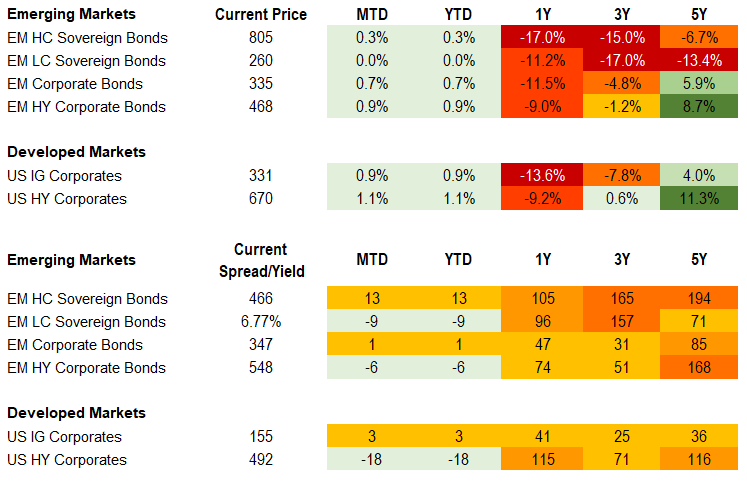
Equities
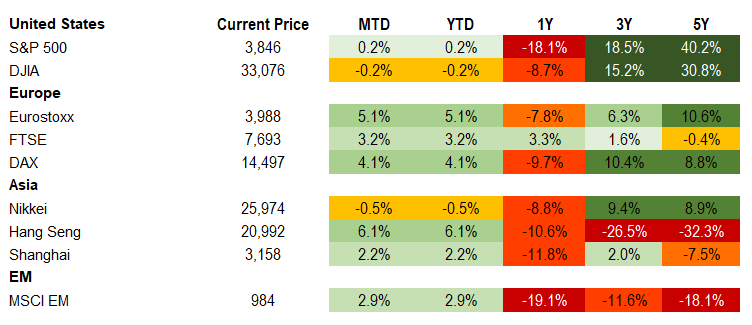
Commodities

Source for data tables: Bloomberg, JPMorgan, Gramercy. EM Fixed Income is represented by the following JPMorgan Indicies: EMBI Global, GBI-EM Global Diversified, CEMBI Broad Diversified and CEMBI Broad High Yield. DM Fixed Income is represented by the JPMorgan JULI Total Return Index and Domestic High Yield Index. Fixed Income, Equity and Commodity data is as of January 6, 2023 (mid-afternoon).
Emerging Markets Weekly Highlights
Putin’s 36-hour ceasefire does not herald the end of war in Ukraine
Event: Russia’s President, Vladimir Putin, announced a 36-hour unilateral ceasefire ordering his troops in Ukraine to pause fighting starting at noon local time on January 6, ahead of Russian Orthodox Christmas on January 7.
Gramercy commentary: We see Putin’s decision as symbolic and catering to appeals by Russia’s influential Orthodox Church and we do not think it is likely to alter anything in the situation on the ground in Ukraine. The authorities in Kyiv have dismissed the Kremlin’s move as a “propaganda gesture” and are highly unlikely to respect any pause in fighting, especially given the momentum that Ukraine’s forces have been enjoying on the battlefield in recent months. A ceasefire announcement by Russia appears particularly odd, given that its forces have been mostly on the defensive since September 2022. In general, we remain pessimistic about the prospect that the conflict comes closer to a resolution in the near-term (in 2023) given that both sides appear to believe that achieving their key objectives remains within reach. Moreover, domestic political pressure for ending the war is not strong in either Kyiv or Moscow, which points to continued fighting that could be prone to significant escalation when the weather conditions in Ukraine start to improve. As we believe that the conflict is set to linger, we remain cautious on Ukraine’s ability to service external debt obligations in the near to medium-term. The duration of the conflict and associated structural economic and geopolitical implications for the country will ultimately determine recovery values for sovereign and other Ukrainian market assets after the conflict is over, but uncertainty on the outlook is extraordinarily elevated and we believe will remain such throughout 2023.
Divergent but still weak China PMIs amid large COVID wave and policy unwind
Event: In December, composite NBS PMI dropped materially further into contractionary territory to 42.6 from 47.1 led by non-manufacturing while the composite Caixin PMI ticked-up to 48.3 from 47.0 led by services. Meanwhile, zero-COVID policy has largely been abandoned with downplayed case and death numbers and announced reopening of international travel on January 8th.
Gramercy commentary: We see the still weak economic data as unsurprising given the speed of the unwind of zero-COVID polices and limited pre-existing immunity driving widespread illness and likely initial caution by the population. Additionally, the pace and nature of rollout at the local level has likely been mixed possibly contributing to the differences in survey data. We anticipate an improvement in activity in 1Q albeit with continued room for volatility given uncertainties associated with both duration and severity of waves and new possible variants. Thereafter, the authorities’ increased emphasis on growth-oriented policies and likely further measures to support the property sector should help to stabilize growth at a higher level than in 2022.
Egypt further adjusting currency in line with IMF program policy goals
Event: The Egyptian Central Bank (CBE) devalued the EGP by roughly 10% this week following two prior sizable adjustments in March and October of this year. At the same time, two large state-owned banks introduced one-year CDs at 25% in the hope of incentivizing local currency holdings.
Gramercy commentary: The further FX adjustment is constructive as it helps preserve FX reserves and is in line with policy under the newly inked $3bn Extended Fund Facility (EFF) with the IMF and $14bn in regional support. While it is too early to know the true degree of flexibility of the pound going forward, the devaluation thus far has helped reduce FX imbalances and the gap between the parallel and official market rates, improving competitiveness. Additionally, with roughly 70% of debt in local currency, the FX adjustment has less impact on debt ratios and sustainability than some peers. Inflation will face additional upward pressure from FX pass-through increasing from November’s print of 16.3% y/y however, local CDs at 25% combined with the FX move should begin to improve local demand for EGP.
Argentina successfully completes third IMF review in December
Event: The IMF approved the third review of Argentina’s EFF triggering a roughly $6bn disbursement. All performance criteria were met with a waiver provided for policy measures that have given rise to new exchange rate restrictions and multiple currency practices. The IMF’s growth and inflation projections for 2022 were revised further upward to 4.6% and 97%, respectively, while the 2023 growth and inflation estimates of 2% and 60%, respectively, remained unchanged. Similarly, the 2023 primary deficit target of 1.9% of GDP is unchanged and aligned with the budget.
Gramercy commentary: The government and IMF’s ability to keep the program on track amid challenging external and domestic conditions is credit positive. This, combined with solid fiscal performance, moderation in the monthly pace of inflation, a successful swap of domestic debt improving the near-term maturity profile, and better external conditions have supported external bond prices for much of 4Q. The still fragile macroeconomic backdrop which has been largely successfully navigated with one-off and temporary measures, most notably the multiple FX rate regime as flagged by the IMF, suggests that room for volatility persists. Nevertheless, we anticipate investor focus to more meaningfully shift to the start of the electoral cycle in the coming months where our base case remains for an outcome with improved governability and policymaking.
Emerging Markets Technicals
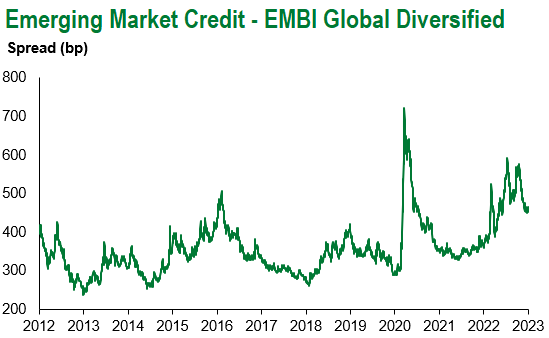
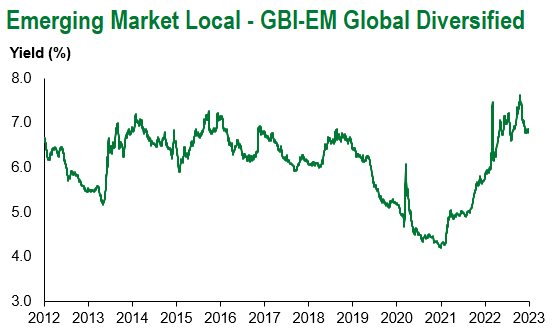
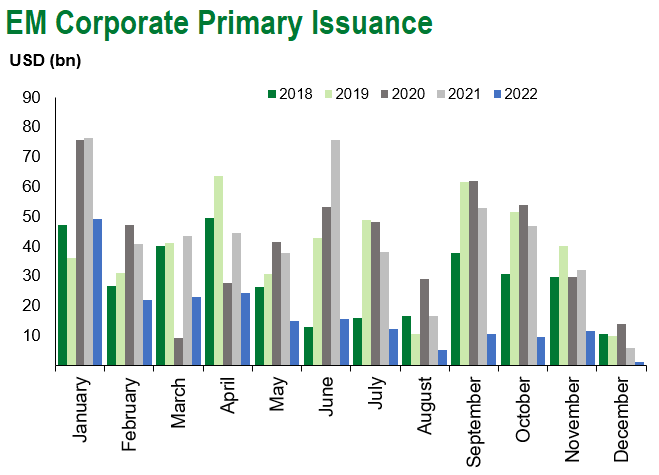
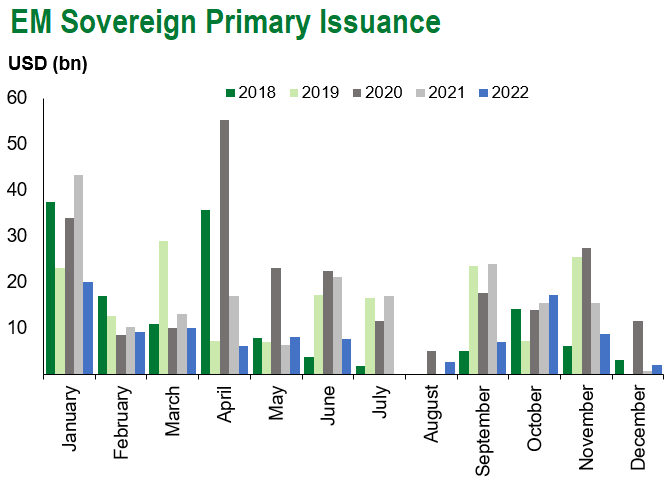
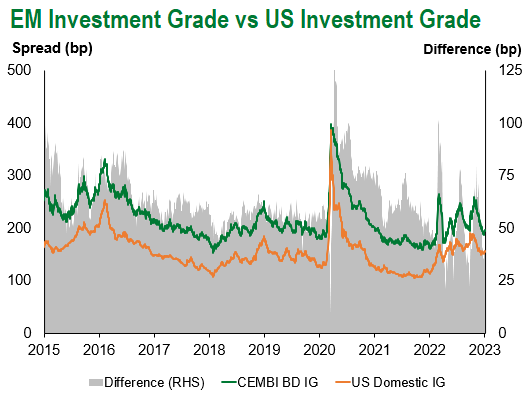
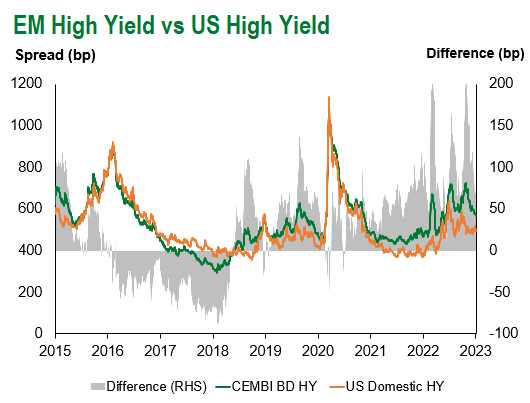
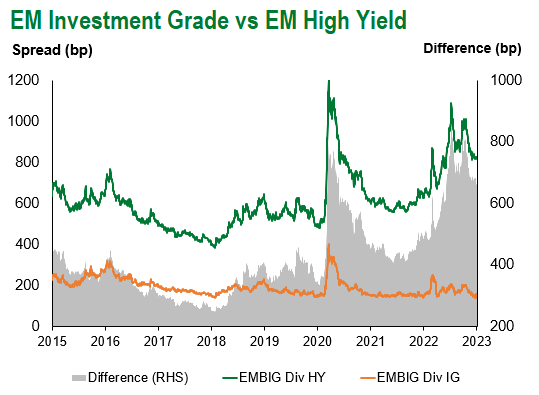
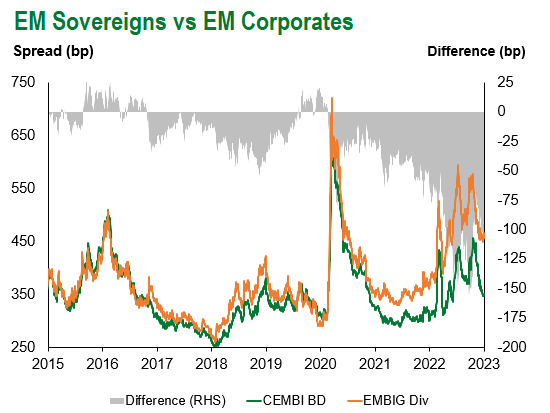
Emerging Markets Flows
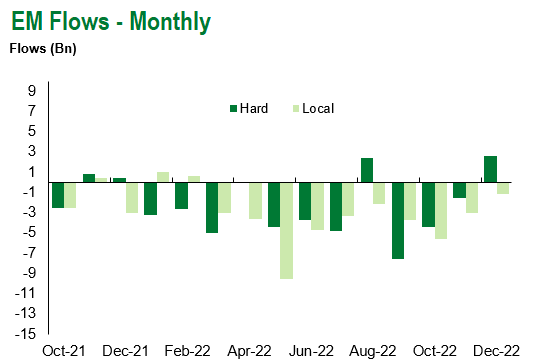
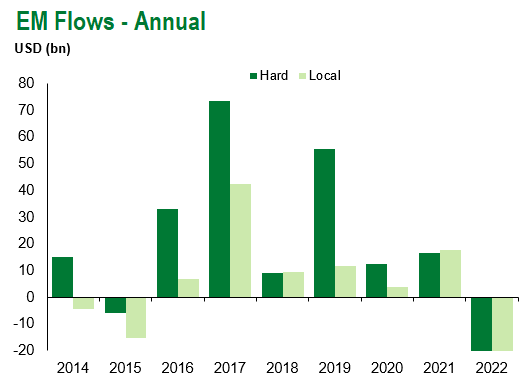
Source for graphs: Bloomberg, JPMorgan, Gramercy. As of January 6, 2023.
COVID Resources:
Johns Hopkins COVID-19 Case Tracker
For questions, please contact:
Kathryn Exum, CFA ESG, Director, Co-Head of Sovereign Research, [email protected]
Petar Atanasov, Director, Co-Head of Sovereign Research, [email protected]
James Barry, Director, Deputy Portfolio Manager, [email protected]
This document is for informational purposes only. The information presented is not intended to be relied upon as a forecast, research or investment advice, and is not a recommendation, offer or solicitation to buy or sell any securities or to adopt any investment strategy. Gramercy may have current investment positions in the securities or sovereigns mentioned above. The information and opinions contained in this paper are as of the date of initial publication, derived from proprietary and nonproprietary sources deemed by Gramercy to be reliable, are not necessarily all-inclusive and are not guaranteed as to accuracy. This paper may contain “forward-looking” information that is not purely historical in nature. Such information may include, among other things, projections and forecasts. There is no guarantee that any forecasts made will come to pass. Reliance upon information in this paper is at the sole discretion of the reader. You should not rely on this presentation as the basis upon which to make an investment decision. Investment involves risk. There can be no assurance that investment objectives will be achieved. Investors must be prepared to bear the risk of a total loss of their investment. These risks are often heightened for investments in emerging/developing markets or smaller capital markets. International investing involves risks, including risks related to foreign currency, limited liquidity, less government regulation, and the possibility of substantial volatility due to adverse political, economic or other developments. References to any indices are for informational and general comparative purposes only. The performance data of various indices mentioned in this update are updated and released on a periodic basis before finalization. The performance data of various indices presented herein was current as of the date of the presentation. Please refer to data returns of the separate indices if you desire additional or updated information. Indices are unmanaged, and their performance results do not reflect the impact of fees, expenses, or taxes that may be incurred through an investment with Gramercy. Returns for indices assume dividend reinvestment. An investment cannot be made directly in an index. Accordingly, comparing results shown to those of such indices may be of limited use. The information provided herein is neither tax nor legal advice. Investors should speak to their tax professional for specific information regarding their tax situation.
